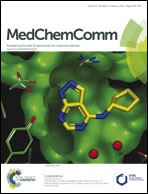The development of thieno[2,3-b]pyridine analogues as anticancer agents applying in silico methods†
Abstract
The chemical space surrounding a class of thieno[2,3-b]pyridines was investigated by testing their commercially available derivatives against the NCI60 panel of human tumour cell lines. The results from the nineteen analogues revealed that ortho- and meta- double substitution (derivative 1) on the phenyl ring is the most active with growth inhibition (GI50) between 20–40 nM for a range of melanoma, breast, lung, central nervous system (CNS) and leukaemia cell lines. It was also discovered that the phenyl moiety can be replaced by α-naphthyl (16) with GI50 in the 60–240 nM range for the same cell lines. Molecular modelling studies show a good fit with a phosphoinositide specific-phospholipase C (PLC) docking scaffold suggesting that these compounds inhibit this enzyme class, which is in line with previous findings. Finally, a virtual screen using the PLC model resulted in four compounds with increased specificity against the leukaemia cell lines compared to the other tumour lines in the NCI60 panel possibly indicating their specificity against the PLC-γ2 isoform.
![Graphical abstract: The development of thieno[2,3-b]pyridine analogues as anticancer agents applying in silico methods](/en/Image/Get?imageInfo.ImageType=GA&imageInfo.ImageIdentifier.ManuscriptID=C3MD00320E&imageInfo.ImageIdentifier.Year=2014)

 Please wait while we load your content...
Please wait while we load your content...